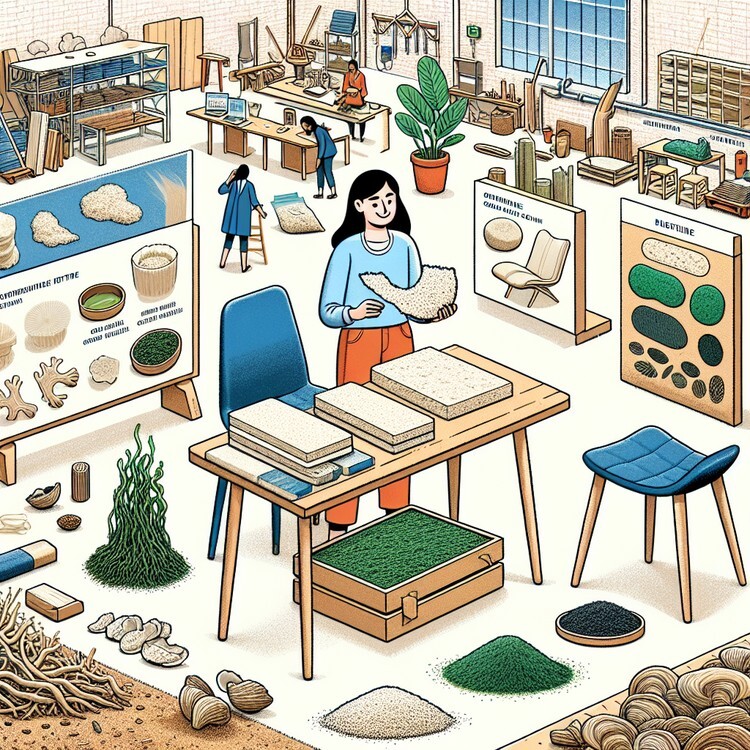Celine Sandberg, the founder of Agoprene, an Oslo-based company, has been experimenting with unconventional materials to create sustainable furniture. Her goal is to reduce the use of plastic polymers, such as polyurethane, in furniture production. Sandberg and her team have tested various materials, including crushed oyster shells, agricultural waste, and wood fibers, to find an environmentally-friendly alternative for filling pillows, sofas, and chair cushions. While most of these materials resulted in rigid foam, they eventually discovered that seaweed could be transformed into a soft foam block suitable for seat cushions and chairs. This seaweed foam is 100% biodegradable and will naturally degrade in the soil within eight months.
Plastic is widely used in the furniture industry, not only in the form of polyurethane but also in polyester, vinyl blends, and wood veneers coated with polymers. Plastic is favored for its versatility and low cost, as it is derived from by-products of oil refining. However, there are significant drawbacks to using plastic in furniture. The Environmental Protection Agency estimates that 12 million tonnes of furniture were discarded in the US in 2018, with 80% ending up in landfills where plastic takes hundreds of years to break down. Additionally, the production of polyurethane foam rubber alone contributes to 105 million tonnes of CO2 emissions annually.
To combat these issues, many companies are seeking alternative materials for furniture production. Danish design company Mater, for example, uses discarded coffee bean shells and sawdust from furniture production to create seats and backrests for their chairs. They also utilize ocean waste for their outdoor furniture. Another unconventional option being explored is fungus. Researchers at Newcastle Upon Tyne’s Hub for Biotechnology in the Built Environment have developed BioKnit, a textile made from mycelium, the root-like structure of fungi. This material decomposes naturally and does not require binders or glue that would persist in landfills.
Major design brands, such as Williams Sonoma and IKEA, are also embracing sustainable materials in their products. Williams Sonoma now uses responsibly sourced cotton and recycled polyester, while IKEA plans to use only renewable and recycled materials by 2030. Sandberg is encouraged by the furniture industry’s willingness to explore new materials and make changes to their production processes. She believes that this openness and curiosity will lead to positive change in the industry’s wasteful practices.
Original news source: The weird materials behind sustainable furniture (BBC)
Listen:
Slow
Normal
Fast
Vocabulary:
| 1 | polymers | Substances made up of many smaller molecules linked together |
| 2 | oyster shells | Shells from a type of shellfish |
| 3 | agricultural waste | Waste material from farming or agricultural activities |
| 4 | wood fibers | Thin strands or threads made from wood |
| 5 | environmentally-friendly | Not harmful to the environment |
| 6 | biodegradable | Capable of being broken down naturally by living organisms |
| 7 | landfills | Sites where waste is buried in the ground |
| 8 | CO2 emissions | The release of carbon dioxide into the atmosphere |
| 9 | discarded | Thrown away or no longer wanted |
| 10 | alternative | Another option or choice |
| 11 | mycelium | The root-like structure of fungi |
| 12 | textile | A type of fabric or cloth |
| 13 | responsibly sourced | Obtained in a way that is ethical and sustainable |
| 14 | renewable | Able to be replaced or replenished |
| 15 | wasteful | Using more of something than is necessary or useful |
Group or Classroom Activities
Warm-up Activities:
– News Summary
Instructions:
1. Divide the class into small groups.
2. Give each group a copy of the article.
3. Instruct the groups to read the article and summarize it in 3-5 sentences.
4. After a designated time, have each group share their summary with the class.
5. Facilitate a discussion by asking questions about the main points of the article and encouraging students to express their opinions.
– Vocabulary Pictionary
Instructions:
1. Divide the class into pairs.
2. Give each pair a list of vocabulary words from the article.
3. Instruct one student to choose a word and draw it on a whiteboard or piece of paper, without using any letters or symbols.
4. The other student must guess the word based on the drawing.
5. After a certain time limit, switch roles and repeat the process with a new word.
6. Encourage students to use the words in sentences to reinforce their understanding of the vocabulary.
– Sketch It
Instructions:
1. Divide the class into small groups.
2. Assign each group a different material mentioned in the article (e.g. crushed oyster shells, seaweed, coffee bean shells, mycelium).
3. Instruct each group to create a sketch of a piece of furniture made using the assigned material.
4. After a designated time, have each group present their sketch to the class and explain why they chose that particular design.
5. Facilitate a discussion by asking questions about the advantages and disadvantages of using each material in furniture production.
– Two Truths and a Lie
Instructions:
1. Instruct each student to come up with two true statements and one false statement related to the article.
2. Divide the class into small groups.
3. Have each student take turns sharing their statements with their group.
4. The other students in the group must guess which statement is the lie.
5. After a designated time, reveal the lie and encourage students to discuss the true statements in more detail.
6. Facilitate a class discussion by asking questions about the facts presented and encouraging students to share their opinions on the topic.
– Pros and Cons
Instructions:
1. Divide the class into pairs.
2. Instruct each pair to discuss the pros and cons of using unconventional materials in furniture production, based on the information in the article.
3. After a designated time, have each pair present their arguments to the class.
4. Facilitate a debate by asking students to respond to each pair’s arguments and share their own opinions on the topic.
5. Encourage students to use persuasive language and support their arguments with evidence from the article.
Comprehension Questions:
1. What is the goal of Celine Sandberg and her company Agoprene?
2. What are some of the unconventional materials that Sandberg has experimented with?
3. Why is plastic widely used in the furniture industry?
4. What are some of the drawbacks of using plastic in furniture?
5. What alternative materials does Danish design company Mater use in their furniture production?
6. What is BioKnit and how is it made?
7. How are major design brands like Williams Sonoma and IKEA embracing sustainable materials?
8. What does Celine Sandberg believe will come from the furniture industry’s willingness to explore new materials?
Go to answers ⇩
Listen and Fill in the Gaps:
Celine Sandberg, the founder of Agoprene, an Oslo-based company, has been (1)______ with unconventional materials to create sustainable furniture. Her goal is to reduce the use of plastic (2)______, such as (3)______, in furniture production. Sandberg and her team have tested various materials, including crushed oyster shells, agricultural waste, and wood fibers, to find an environmentally-friendly alternative for filling pillows, sofas, and chair cushions. While most of these materials resulted in rigid foam, they eventually discovered that (4)______ could be transformed into a soft foam block suitable for seat cushions and chairs. This seaweed foam is 100% biodegradable and will naturally degrade in the soil within eight months.
(5)______ is widely used in the furniture industry, not only in the form of polyurethane but also in polyester, vinyl (6)______, and wood veneers coated with polymers. Plastic is favored for its (7)______ and low cost, as it is derived from by-products of oil refining. However, there are significant drawbacks to using plastic in furniture. The (8)______ Protection Agency estimates that 12 million tonnes of furniture were discarded in the US in 2018, with 80% ending up in landfills where plastic takes hundreds of years to break down. Additionally, the production of polyurethane foam rubber alone contributes to 105 million tonnes of CO2 (9)______ annually.
To combat these issues, many (10)______ are seeking alternative materials for furniture production. Danish design company Mater, for example, uses discarded coffee bean shells and sawdust from furniture production to create seats and backrests for their chairs. They also utilize ocean waste for their outdoor furniture. Another unconventional (11)______ being explored is fungus. Researchers at Newcastle Upon Tyne’s Hub for Biotechnology in the Built Environment have (12)______ BioKnit, a textile made from mycelium, the root-like structure of fungi. This material decomposes naturally and does not (13)______ binders or glue that would persist in landfills.
Major (14)______ brands, such as Williams Sonoma and IKEA, are also embracing sustainable materials in their products. Williams Sonoma now uses responsibly sourced cotton and recycled polyester, while IKEA (15)______ to use only renewable and recycled materials by 2030. Sandberg is encouraged by the furniture industry’s willingness to explore new materials and make changes to their production processes. She believes that this (16)______ and curiosity will lead to positive change in the industry’s wasteful practices.
Go to answers ⇩
Discussion Questions:
Students can ask a partner these questions, or discuss them as a group.
1. What is the goal of Celine Sandberg and her company Agoprene?
2. How would you feel if all furniture was made from sustainable materials?
3. Do you like the idea of using unconventional materials like crushed oyster shells and seaweed for furniture? Why or why not?
4. Do you think it’s important for the furniture industry to reduce its use of plastic? Why or why not?
5. What are some drawbacks of using plastic in furniture production?
6. How would you feel if all furniture was made from materials that naturally decompose and do not contribute to landfills?
7. Do you think more companies should follow the example of Mater and use discarded materials for furniture production? Why or why not?
8. What are some other unconventional materials that could be used for furniture production?
9. How do you think using sustainable materials in furniture production could impact the environment?
10. Do you think the furniture industry is doing enough to combat its wasteful practices? Why or why not?
11. How would you feel if all major design brands embraced sustainable materials in their products?
12. What are some challenges that companies may face when transitioning to sustainable materials for furniture production?
13. How do you think the use of sustainable materials in furniture production could impact the price of furniture?
14. Do you think consumers are willing to pay more for furniture made from sustainable materials? Why or why not?
15. Why do you think it’s important for the furniture industry to explore new materials and make changes to their production processes?
Individual Activities
Vocabulary Meanings:
Match each word to its meaning.
Words:
1. polymers
2. oyster shells
3. agricultural waste
4. wood fibers
5. environmentally-friendly
6. biodegradable
7. landfills
8. CO2 emissions
9. discarded
10. alternative
11. mycelium
12. textile
13. responsibly sourced
14. renewable
15. wasteful
Meanings:
(A) Thin strands or threads made from wood
(B) Using more of something than is necessary or useful
(C) Obtained in a way that is ethical and sustainable
(D) A type of fabric or cloth
(E) Sites where waste is buried in the ground
(F) The release of carbon dioxide into the atmosphere
(G) The root-like structure of fungi
(H) Capable of being broken down naturally by living organisms
(I) Thrown away or no longer wanted
(J) Not harmful to the environment
(K) Another option or choice
(L) Waste material from farming or agricultural activities
(M) Substances made up of many smaller molecules linked together
(N) Shells from a type of shellfish
(O) Able to be replaced or replenished
Go to answers ⇩
Multiple Choice Questions:
1. What is the goal of Celine Sandberg and her team at Agoprene?
(a) To increase the use of plastic polymers in furniture production
(b) To find new uses for plastic polymers in furniture production
(c) To eliminate the use of plastic polymers in furniture production
(d) To reduce the use of plastic polymers in furniture production
2. Which material did Sandberg and her team discover could be transformed into a soft foam block for seat cushions and chairs?
(a) Crushed oyster shells
(b) Seaweed
(c) Agricultural waste
(d) Wood fibers
3. What is a significant drawback of using plastic in furniture production?
(a) It takes hundreds of years to break down in landfills
(b) It is too expensive to produce
(c) It is not versatile enough for furniture design
(d) It does not contribute to CO2 emissions
4. What alternative materials does Danish design company Mater use for their chairs?
(a) Seaweed and agricultural waste
(b) Crushed oyster shells and wood fibers
(c) Discarded coffee bean shells and sawdust
(d) Polyester and vinyl blends
5. What is BioKnit, developed by researchers at Newcastle Upon Tyne’s Hub for Biotechnology in the Built Environment?
(a) A foam block made from seaweed
(b) A material made from crushed oyster shells
(c) A synthetic polymer used for furniture production
(d) A textile made from mycelium, the root-like structure of fungi
6. What sustainable materials does Williams Sonoma now use in their products?
(a) Seaweed and agricultural waste
(b) Crushed oyster shells and wood fibers
(c) Responsibly sourced cotton and recycled polyester
(d) Polyester and vinyl blends
7. What is IKEA’s goal for their materials by 2030?
(a) To use only renewable and recycled materials
(b) To increase the use of plastic polymers
(c) To eliminate the use of plastic polymers
(d) To use only polyester and vinyl blends
8. What does Sandberg believe will lead to positive change in the furniture industry’s wasteful practices?
(a) The use of plastic polymers in furniture production
(b) The industry’s willingness to explore new materials and make changes to their production processes
(c) The elimination of plastic polymers in furniture production
(d) The increase in CO2 emissions from furniture production
Go to answers ⇩
True or False Questions:
1. The seaweed foam is not 100% biodegradable and will not naturally degrade in the soil within eight months.
2. The production of polyurethane foam rubber contributes to 105 million tonnes of CO2 emissions annually.
3. Celine Sandberg is the founder of Agoprene, a company based in Oslo.
4. Sandberg’s goal is to reduce the use of plastic polymers in furniture production.
5. Sandberg and her team have not experimented with materials such as crushed oyster shells, agricultural waste, and wood fibers.
6. Mater does not use discarded coffee bean shells and sawdust to create seats and backrests for their chairs.
7. Williams Sonoma and IKEA are not major design brands that are embracing sustainable materials in their products.
8. They discovered that seaweed can be transformed into a soft foam block suitable for seat cushions and chairs.
Go to answers ⇩
Write a Summary:
Write a summary of this news article in two sentences.
Check your writing now with the best free AI for English writing!
Writing Questions:
Answer the following questions. Write as much as you can for each answer.
Check your answers with our free English writing assistant!
1. What materials has Celine Sandberg experimented with to create sustainable furniture?
2. What is the environmental impact of using plastic in furniture production?
3. How are companies like Mater and Newcastle Upon Tyne’s Hub for Biotechnology in the Built Environment seeking alternative materials for furniture production?
4. How are major design brands like Williams Sonoma and IKEA incorporating sustainable materials into their products?
5. What does Celine Sandberg believe will lead to positive change in the furniture industry’s wasteful practices?
Answers
Comprehension Question Answers:
1. The goal of Celine Sandberg and her company Agoprene is to reduce the use of plastic polymers in furniture production and find environmentally-friendly alternatives.
2. Some of the unconventional materials that Sandberg has experimented with include crushed oyster shells, agricultural waste, wood fibers, and seaweed.
3. Plastic is widely used in the furniture industry because of its versatility and low cost. It is derived from by-products of oil refining.
4. Some of the drawbacks of using plastic in furniture include its contribution to landfill waste, as plastic takes hundreds of years to break down, and its production process, which emits a significant amount of CO2.
5. Danish design company Mater uses discarded coffee bean shells, sawdust from furniture production, and ocean waste in their furniture production.
6. BioKnit is a textile made from mycelium, the root-like structure of fungi. It decomposes naturally and does not require binders or glue that would persist in landfills.
7. Major design brands like Williams Sonoma and IKEA are embracing sustainable materials by using responsibly sourced cotton, recycled polyester, and renewable and recycled materials in their products.
8. Celine Sandberg believes that the furniture industry’s willingness to explore new materials and make changes to their production processes will lead to positive change and reduce wasteful practices.
Go back to questions ⇧
Listen and Fill in the Gaps Answers:
(1) experimenting
(2) polymers
(3) polyurethane
(4) seaweed
(5) Plastic
(6) blends
(7) versatility
(8) Environmental
(9) emissions
(10) companies
(11) option
(12) developed
(13) require
(14) design
(15) plans
(16) openness
Go back to questions ⇧
Vocabulary Meanings Answers:
1. polymers
Answer: (M) Substances made up of many smaller molecules linked together
2. oyster shells
Answer: (N) Shells from a type of shellfish
3. agricultural waste
Answer: (L) Waste material from farming or agricultural activities
4. wood fibers
Answer: (A) Thin strands or threads made from wood
5. environmentally-friendly
Answer: (J) Not harmful to the environment
6. biodegradable
Answer: (H) Capable of being broken down naturally by living organisms
7. landfills
Answer: (E) Sites where waste is buried in the ground
8. CO2 emissions
Answer: (F) The release of carbon dioxide into the atmosphere
9. discarded
Answer: (I) Thrown away or no longer wanted
10. alternative
Answer: (K) Another option or choice
11. mycelium
Answer: (G) The root-like structure of fungi
12. textile
Answer: (D) A type of fabric or cloth
13. responsibly sourced
Answer: (C) Obtained in a way that is ethical and sustainable
14. renewable
Answer: (O) Able to be replaced or replenished
15. wasteful
Answer: (B) Using more of something than is necessary or useful
Go back to questions ⇧
Multiple Choice Answers:
1. What is the goal of Celine Sandberg and her team at Agoprene?
Answer: (d) To reduce the use of plastic polymers in furniture production
2. Which material did Sandberg and her team discover could be transformed into a soft foam block for seat cushions and chairs?
Answer: (b) Seaweed
3. What is a significant drawback of using plastic in furniture production?
Answer: (a) It takes hundreds of years to break down in landfills
4. What alternative materials does Danish design company Mater use for their chairs?
Answer: (c) Discarded coffee bean shells and sawdust
5. What is BioKnit, developed by researchers at Newcastle Upon Tyne’s Hub for Biotechnology in the Built Environment?
Answer: (d) A textile made from mycelium, the root-like structure of fungi
6. What sustainable materials does Williams Sonoma now use in their products?
Answer: (c) Responsibly sourced cotton and recycled polyester
7. What is IKEA’s goal for their materials by 2030?
Answer: (a) To use only renewable and recycled materials
8. What does Sandberg believe will lead to positive change in the furniture industry’s wasteful practices?
Answer: (b) The industry’s willingness to explore new materials and make changes to their production processes
Go back to questions ⇧
True or False Answers:
1. The seaweed foam is not 100% biodegradable and will not naturally degrade in the soil within eight months. (Answer: False)
2. The production of polyurethane foam rubber contributes to 105 million tonnes of CO2 emissions annually. (Answer: True)
3. Celine Sandberg is the founder of Agoprene, a company based in Oslo. (Answer: True)
4. Sandberg’s goal is to reduce the use of plastic polymers in furniture production. (Answer: True)
5. Sandberg and her team have not experimented with materials such as crushed oyster shells, agricultural waste, and wood fibers. (Answer: False)
6. Mater does not use discarded coffee bean shells and sawdust to create seats and backrests for their chairs. (Answer: False)
7. Williams Sonoma and IKEA are not major design brands that are embracing sustainable materials in their products. (Answer: False)
8. They discovered that seaweed can be transformed into a soft foam block suitable for seat cushions and chairs. (Answer: True)
Go back to questions ⇧













